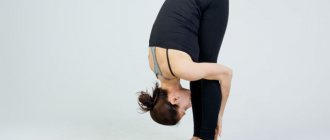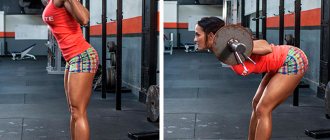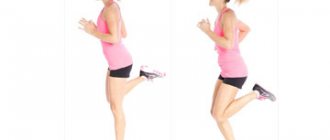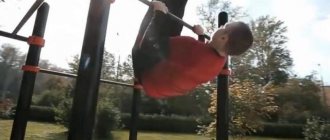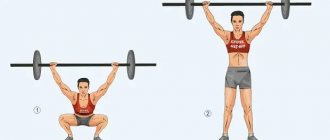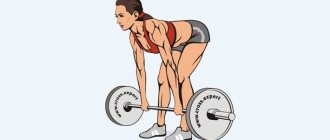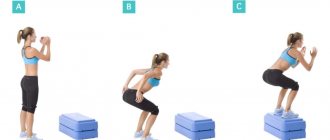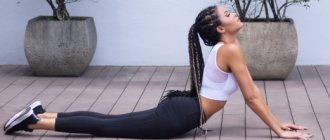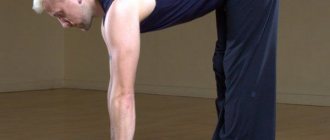Regular forward bends develop the posterior chain. Exercise, even without weights, strengthens the long back muscles, increases hip mobility, improves flexibility, and develops the hamstrings and glutes. Common in gymnastics and various types of rehabilitation training. In strength training, it is performed in the “good morning” variation, that is, bending forward with a barbell. Some methodologists consider the Romanian and dead deadlifts to be variations of the incline. This is correct, since in all three movements flexion occurs only in the hip joint.
Execution technique
Initial position
- Feet under the pelvic bones or slightly wider;
- The arms can be extended both along the body, if you plan to learn deadlifts, and above the head;
- The back is neutral, there is no need to remove the natural deflection of the spine with the help of strong retraction of the abdomen;
- Bend forward while inhaling.
Performance
- Bend at the hips;
- Move your pelvis back;
- The knees are soft;
- The arms remain extended along the body or above the head;
- Bend to the depth to which your back remains straight;
- As you exhale, rise to the starting position and actively continue to perform the exercise;
- The pace of bending without weight is calm - flexion and extension while inhaling and exhaling.
►Bends forward without harming the spine.
Attention
- It is forbidden to perform the exercise at a jerky pace; a forced rise eliminates the possibility of working out the muscles, makes it easier to enter the bend, but does not allow you to control the position of the back. Speed work in this exercise is available only to well-developed gymnasts, who have access to both full amplitude and high speed;
- You should not lift your head, this will not help pump your muscles more effectively;
- It’s also not a good idea to place your chin on your chest;
- Instead of jerking movements, you should smoothly lower and raise your body;
- The spine remains straight, natural lordosis is preserved;
- Unnecessary movements of the knees like a classic deadlift (pushing with the legs) are excluded.
Bend the torso forward from a standing position
The material was prepared by the site team with the support of our experts: athletes, coaches and nutrition specialists.
Our team >> Forward bends are a simple exercise known to many since childhood, which allows you to develop the flexibility of the spine and tone the muscles of the abs, back and buttocks. In addition, this exercise is included in the GTO standards. Therefore, for all those who want to have a beautiful flexible body and be proud of their physical shape, performing forward bends is a mandatory part of the program.
Recommendations
- The legs should be kept as “excluded” from the movement as possible, the knees are either slightly bent or straightened, but the entire position of the hips prevents pushing off the floor;
- There is no need to push yourself with all your might into the deepest inclination, stay at the level that is natural for the body;
- Don't slouch;
- Eliminate unnecessary tension on the hamstrings by bending your knees and locking them in a flexed position if you are not comfortable;
- Work more through the buttocks and thigh muscles, rather than through the lower back
Why do it?
Leaning your torso forward is a completely natural movement for the human body. Performing the exercise does not require any physical training or sports equipment. It is ideal for independent training at home.
Effect on the body:
- Forward bending of the torso improves the flexibility of the spine and the mobility of the hip joints.
- There is a training session to stretch the hamstrings and muscles of the back of the thighs. Especially if you do the exercise with straight legs.
- Strengthening the muscles of the abs, back, buttocks.
- Improving blood circulation, preventing vascular diseases of the head.
Execution options
- Bends from a sitting position . You need to sit on a gymnastics bench or bench for bench press. Bends forward, exhaling with effort, that is, while standing up. This is a very specific variation, it is used in sports as a way to increase mobility in the hip joints;
- Bends in depth . This is an option while standing on a stand; it is suitable for those who have enough amplitude and who can actually bend below the level of their feet so as not to bend their back completely.
Bend forward on a gymnastic bench
Bend forward from a standing position
Regular forward bends develop the posterior chain. Exercise, even without weights, strengthens the long back muscles, increases hip mobility, improves flexibility, and develops the hamstrings and glutes. Common in gymnastics and various types of rehabilitation training. In strength training, it is performed in the “good morning” variation, that is, bending forward with a barbell. Some methodologists consider the Romanian and dead deadlifts to be variations of the incline. This is correct, since in all three movements flexion occurs only in the hip joint.
Analysis of the exercise
What muscles work
- Ideally, the main muscles are the gluteus maximus and medius, the hamstrings and long back muscles. How stabilizers work the abdominal muscles
- Auxiliary - semimembranosus, semitendinosus, as well as gastrocnemius and flexor digitorum longus.
pros
- Does not place a large axial load on the spine;
- Increases flexibility;
- Improves the elasticity of the muscles of the back of the thigh;
- Relaxes after strength training, relieves congestion, and can be an excellent option for active recovery;
- Helps improve abdominal muscle tone;
- Helps you gain the necessary sensorimotor skills to perform Romanian deadlifts, stiff legged deadlifts and classic deadlifts;
- It is a preparatory movement for classic good morninging;
- Improves mobility of the hip joint.
Minuses
- Not suitable for athletes with poor flexibility
- Preparation
- The exercise requires a well-warmed body and decent mobility in the joints. It must be performed after a general warm-up. As a special exercise, knee lifts to the chest are done, as well as shallow bends.
- Those performing the movement itself as a prep for deadlifts should still do a general warm-up and a set of leg raises at the beginning of the workout to increase amplitude.
- You can also do a couple of warm-up approaches with incomplete amplitude.
Proper execution
- The feet should be either the width of the pelvic bones, or slightly wider or narrower, but there should be no discomfort when working in the hip joints;
- The legs remain straight during movement and do not bend at the knees;
- The back can be slightly rounded in the thoracic region, if this is a person’s natural posture, but bending the lumbar region “dome” upward is prohibited, as in all types of deadlifts.
Bend forward from a standing position. Effective and safe
Errors
- Performing a classic deadlift, that is, pushing off the floor with bending the knees;
- Tilt to one side, that is, touching the floor with one hand by contracting the oblique abdominal muscles on one side;
- Work with the lower back, tension in this area during lifting;
- Chaotic breathing during exercise or holding it;
- There is no fixation, that is, the movement is not performed to the maximum amplitude and always to a different depth.
Efficiency Tips
- You need to stay for some time at the lower point of the amplitude, performing the exercise as efficiently as possible;
- Do not push your body into the working amplitude too actively, move smoothly, work to gradually deepen the amplitude;
- Use stands only when there is a lack of amplitude and you need to deepen it, do not force this process;
- If the goal is to strengthen the muscles, perform the exercise with weights, move on to the Romanian deadlift and straight leg deadlift;
- Beginners can make the movement more difficult by extending their arms behind their back, or clasping them behind their back;
- Alternate this exercise with a seated variation, which is used to improve amplitude in the hip joints;
- You can do the exercise with support on one leg, and the other slightly back. This way you can work your hamstrings more;
- To increase the load on the muscles of the buttocks and thighs, you should alternate this exercise with the King deadlift.
Table of standards
M - boys, youths, men
F - girls, girls, women
B - bronze badge
C - silver badge
Z - gold sign
| M | AND | |||||
| B | WITH | Z | B | WITH | Z | |
| Stage I (6-8 years) | +1 | +3 | +7 | +3 | +5 | +9 |
| II stage (9-10 years) | +2 | +4 | +8 | +3 | +5 | +11 |
| III stage (11-12 years) | +3 | +5 | +9 | +4 | +6 | +13 |
| IV stage (13-15 years) | +4 | +6 | +11 | +5 | +8 | +15 |
| V stage (16-17 years old) | +6 | +8 | +13 | +7 | +9 | +16 |
| VI stage (18-24 years old) | +6 | +8 | +13 | +8 | +11 | +16 |
| VI stage (25-29 years old) | +5 | +7 | +12 | +7 | +9 | +14 |
| VII stage (30-34 years) | +3 | +5 | +11 | +5 | +7 | +13 |
| VII stage (35-39 years) | +2 | +4 | +10 | +4 | +6 | +12 |
| VIII stage (40-44 years) | +1 | +3 | +9 | +2 | +4 | +11 |
| VIII stage (45-49 years) | 0 | +2 | +8 | +2 | +4 | +10 |
| IX stage (50-54 years old) | -1 | +1 | +7 | +1 | +3 | +9 |
| IX stage (55-59 years old) | -2 | 0 | +5 | +1 | +3 | +8 |
| X stage (60-64 years old) | -6 | -4 | -1 | 0 | +2 | +6 |
| X stage (65-69 years) | -8 | -6 | -4 | -4 | -1 | +2 |
| XI stage (70 years and older) | -10 | -8 | -6 | -6 | -4 | 0 |
Note: When performing an exercise standing on the floor for primary and secondary school age (I and II levels), touching the floor with your fingers to receive a bronze and silver badge, pressing your palms to the floor for a gold badge counts. For senior school age (III level), touching with fingers counts for all signs.
Inclusion in the program
The exercise is included in the program of those who perform strength training as a warm-up. It is done at the beginning of training for 5-10 repetitions to stretch the muscles and increase mobility in the joints. But this is not always the rule. Beginners can do the exercise as an independent strength exercise. Continuing exercises - as an exercise for a more “detailed” warm-up, if required.
Contraindications
- Movement is excluded during rehabilitation from a hamstring injury;
- It is not performed if there are problems with intracranial pressure or headaches;
- It is worth avoiding if the sciatic nerve is inflamed (there is no need to stretch it, you should pump up the quadriceps);
- It is recommended to refrain from exercising if you have runner's foot or heel spurs until the problem is completely corrected using foot strengthening exercises;
- It is necessary to abandon the exercise in case of exacerbations of hernias and protrusions with pain. If there is no pain, you can perform the exercise as the main one;
- Bends forward are not recommended for pregnant women in the third trimester, unless we are talking about shallow bends;
- You should abandon the exercise if cervical osteochondrosis has worsened;
- You need to stop doing the exercise if your knees hurt, but there is no injury, you should figure out the source of the pain and eliminate it.
So, forward bends can be used as an element of warm-up, deadlift training, or training during training. This exercise is great for anyone who has problems with hip mobility and weak hamstrings.
These Miracles will happen if you do bends every day! Why are they silent about this...
Igor June 15, 2020
Story
The origins of physical exercise go back a long way. They were directly related to a person’s satisfaction of vital instincts and needs for food, shelter, warmth, procreation, movement, etc. To survive, a person had to improve his physical qualities: speed, strength, flexibility, endurance, agility.
With the development of human society, the similarity between labor actions and physical exercise itself was lost. From the complex motor activities associated with the labor process, individual actions were gradually isolated, which then began to be used in physical education as exercises (running, throwing, jumping, bending, etc.). Exercises were specially created for various muscle groups. They were performed with and without objects. Sports games are gradually appearing: basketball, tennis, hockey, football, gymnastics, etc.
Peter I can be considered the founder of physical education in Russia. In the conditions of great transformations in Russia, Peter I created secular educational institutions in the country in which physical education was introduced.
Flexibility is the ability to perform movements with a large amplitude. Good flexibility ensures freedom and economy of movement when performing physical exercises. The direction of development of flexibility does not have a creator and a specific founding date. Presumably, the direction appeared stemming from medicine, which since ancient times has identified a connection between conditions in the muscles, joints and skin and human health.
Flexibility develops most intensively between the ages of 14 and 16. It is recommended to purposefully develop flexibility from the age of 6 years. The means used are exercises that are performed with maximum amplitude. Flexibility exercises solve not only the problem of achieving the required range of motion. They provide strengthening of the joints that are subject to training, as well as tendons and muscle groups. In addition, they develop such an important muscle quality as elasticity. Finally, they can be used as a means of outdoor activities.
